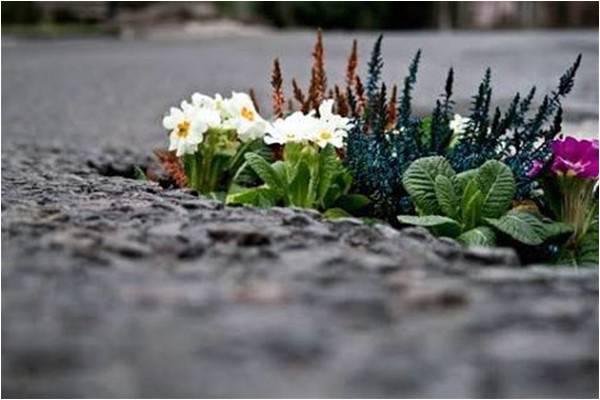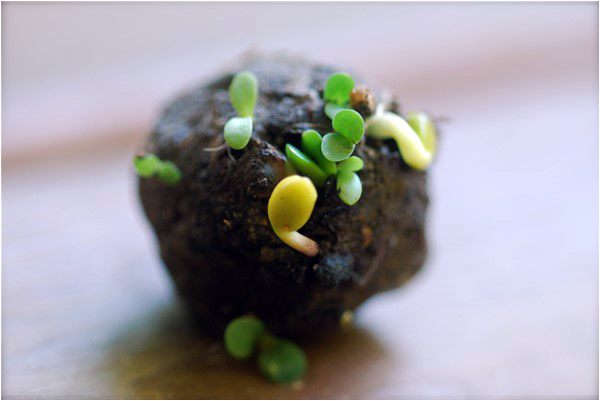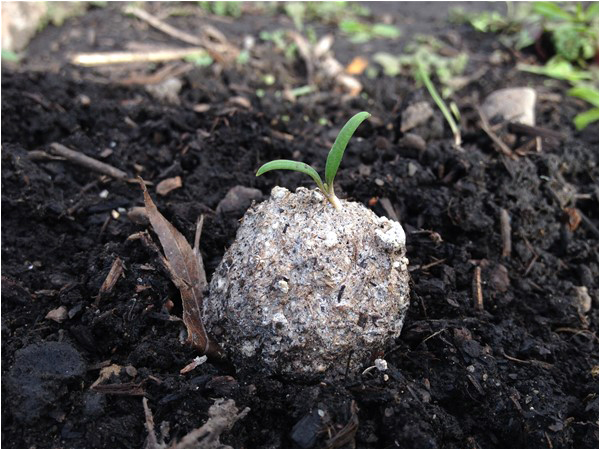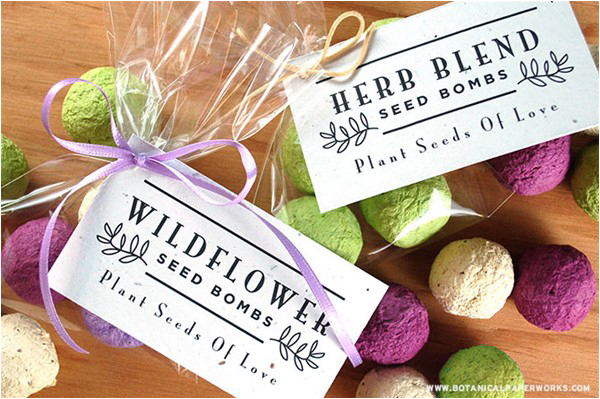
Many of us are fascinated by the idea of seed bombs that recently popped up on social media. Did you know that seed bombs are an ancient practice of growing plants?
From ancient native tribes of America to modern-day organic farmers of Nepal: everyone seems to be appreciating this super-innovative yet simple way of growing food, trees, ground cover and flowers without any human interaction.
Back in 1938 Masanobu Fukuoka, a Japanese microbiologist and author of The One-Straw Revolution: An Introduction to Natural Farming, reintroduced seed bombs. Fukuoka is well known for his powerful and philosophical understanding of sustainable agriculture. He promoted natural farming and believed in simple, pollution-free, non-mechanised, organic and no-tilt farming.

Seed bombs, earth balls or nendo dango (in Japanese) were a part of his regular growing regime. He believed that nature is like a mother to these seeds and decides which crops to offer us. This natural selection is an ongoing phenomenon where nature decides which seed will germinate and which will not.
Fukuoka used to grow vegetables through seed bombs, much like wild plants. He referred to it as a semi-wild method of growing vegetables. He was convinced that vegetables should be allowed to grow alongside weeds. For him, root vegetables in particular – like radish, carrots, onions and turnips – grow stronger that way – at least according to his observations. He would throw seed bombs on river banks, roadsides, etc.
My friend Govinda Sharma jee who runs the HASERA agriculture research and training centre in Nepal makes tennis-ball-sized seed balls using a combo of seeds which can be grown as companion plants. His famous combo is of the three sisters; corn, pumpkin and beans.

Tackling deforestation through seed bombs
Seed bombs have been used since many decades to grow forests. The Kenyan government has led many such campaigns in which they used special aircraft to spread seed bombs across barren lands. Aerial seeding has changed the landscape for many countries and helped preserve and re-grow forests. These countries include China, Canada, USA, New Zealand, Kenya and Australia. At some point, it was also done in Pakistan.
In fact, we really need to do it again!
Guerrilla gardeners and DIY seed bomb campaigns
Guerrilla gardening has become a trend around the world. The idea is simple: go plant something on an empty unclaimed space. Seed bombs naturally became a fast solution.
New York witnessed the beginning of the Green Guerrilla campaigns in the 1970s, which were based on the idea of ‘green grenades’ or seed bombs. These were made from peat moss and chemical fertiliser filled in glass bulbs or Christmas baubles. Guerrilla gardeners developed their own techniques and mixtures.
Christopher 1594 came up the classic combo of 5:1:1 clay, compost and seeds in the shape of revolvers. Kabloom made the ‘Seedbom’ – a new combo for guerrilla gardeners with added recycled paper, egg boxes, tea bags, etc.

DIY seed bombs
The idea is to combine all the necessary ingredients that a seedling may need to survive. Seed bombs or seed balls are simply a mixture of clay, fertiliser and seeds – all of which is moulded into tiny balls to be thrown on empty plots and grounds. When it rains, water is absorbed by the clay and seeds begin to sprout.
Here’s how to make the classic mixture.
Take 5 parts clay and 1 part each of compost and seeds. Mix a little water to turn the mixture into balls. Let it dry or use it fresh.
Some ideas
Native tree seed balls: Collect the seeds of Neem, Gulmohar, Amaltas, jamun, keekar, ipil ipil, sojhna and other trees and make seed balls to be planted on barren ground.
Bajra seed bombs: Use pearl millet or bajra mixed with sunflower seeds to be thrown on empty plots to grow food for wildlife.
Butterfly earth balls: Add a mixture of wild flowers seeds to your seed bomb mixture to grow a beautiful self-seeding garden anywhere!
Vegetable seed bombs: Use seeds of spinach, gourds, eggplants and beans to grow some greens during monsoon.
I personally tried making seed bombs back in 2009. It was such a fun thing to do. It was challenging to find potters’ clay in Karachi but then I collected clay from new plants that arrived from Punjab. It was simple to make and plant as well. I remember launching my green bombs from the top of a building. They landed on an empty plot. It was monsoon and soon some wonderful bajra began to grow.
Zahra Ali is a sustainability educator, writer and environmentalist. She blogs at cropsinpots.pk. Send in questions about gardening to Zahra@cropsinpots.pk
From ancient native tribes of America to modern-day organic farmers of Nepal: everyone seems to be appreciating this super-innovative yet simple way of growing food, trees, ground cover and flowers without any human interaction.
Back in 1938 Masanobu Fukuoka, a Japanese microbiologist and author of The One-Straw Revolution: An Introduction to Natural Farming, reintroduced seed bombs. Fukuoka is well known for his powerful and philosophical understanding of sustainable agriculture. He promoted natural farming and believed in simple, pollution-free, non-mechanised, organic and no-tilt farming.

Seed bombs, earth balls or nendo dango (in Japanese) were a part of his regular growing regime. He believed that nature is like a mother to these seeds and decides which crops to offer us. This natural selection is an ongoing phenomenon where nature decides which seed will germinate and which will not.
Fukuoka used to grow vegetables through seed bombs, much like wild plants. He referred to it as a semi-wild method of growing vegetables. He was convinced that vegetables should be allowed to grow alongside weeds. For him, root vegetables in particular – like radish, carrots, onions and turnips – grow stronger that way – at least according to his observations. He would throw seed bombs on river banks, roadsides, etc.
My friend Govinda Sharma jee who runs the HASERA agriculture research and training centre in Nepal makes tennis-ball-sized seed balls using a combo of seeds which can be grown as companion plants. His famous combo is of the three sisters; corn, pumpkin and beans.

Tackling deforestation through seed bombs
Seed bombs have been used since many decades to grow forests. The Kenyan government has led many such campaigns in which they used special aircraft to spread seed bombs across barren lands. Aerial seeding has changed the landscape for many countries and helped preserve and re-grow forests. These countries include China, Canada, USA, New Zealand, Kenya and Australia. At some point, it was also done in Pakistan.
In fact, we really need to do it again!
Guerrilla gardeners and DIY seed bomb campaigns
Guerrilla gardening has become a trend around the world. The idea is simple: go plant something on an empty unclaimed space. Seed bombs naturally became a fast solution.
New York witnessed the beginning of the Green Guerrilla campaigns in the 1970s, which were based on the idea of ‘green grenades’ or seed bombs. These were made from peat moss and chemical fertiliser filled in glass bulbs or Christmas baubles. Guerrilla gardeners developed their own techniques and mixtures.
Christopher 1594 came up the classic combo of 5:1:1 clay, compost and seeds in the shape of revolvers. Kabloom made the ‘Seedbom’ – a new combo for guerrilla gardeners with added recycled paper, egg boxes, tea bags, etc.

DIY seed bombs
The idea is to combine all the necessary ingredients that a seedling may need to survive. Seed bombs or seed balls are simply a mixture of clay, fertiliser and seeds – all of which is moulded into tiny balls to be thrown on empty plots and grounds. When it rains, water is absorbed by the clay and seeds begin to sprout.
Here’s how to make the classic mixture.
Take 5 parts clay and 1 part each of compost and seeds. Mix a little water to turn the mixture into balls. Let it dry or use it fresh.
Some ideas
Native tree seed balls: Collect the seeds of Neem, Gulmohar, Amaltas, jamun, keekar, ipil ipil, sojhna and other trees and make seed balls to be planted on barren ground.
Bajra seed bombs: Use pearl millet or bajra mixed with sunflower seeds to be thrown on empty plots to grow food for wildlife.
Butterfly earth balls: Add a mixture of wild flowers seeds to your seed bomb mixture to grow a beautiful self-seeding garden anywhere!
Vegetable seed bombs: Use seeds of spinach, gourds, eggplants and beans to grow some greens during monsoon.
I personally tried making seed bombs back in 2009. It was such a fun thing to do. It was challenging to find potters’ clay in Karachi but then I collected clay from new plants that arrived from Punjab. It was simple to make and plant as well. I remember launching my green bombs from the top of a building. They landed on an empty plot. It was monsoon and soon some wonderful bajra began to grow.
Zahra Ali is a sustainability educator, writer and environmentalist. She blogs at cropsinpots.pk. Send in questions about gardening to Zahra@cropsinpots.pk

